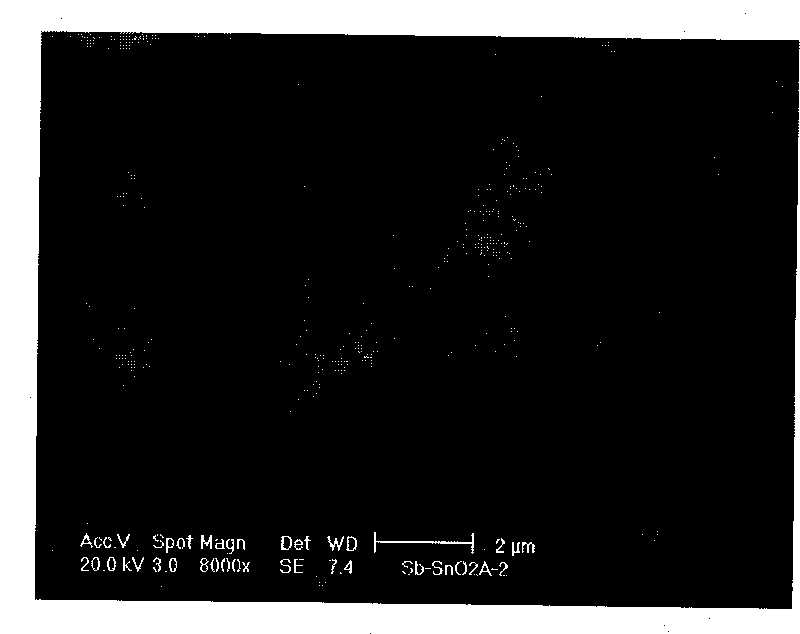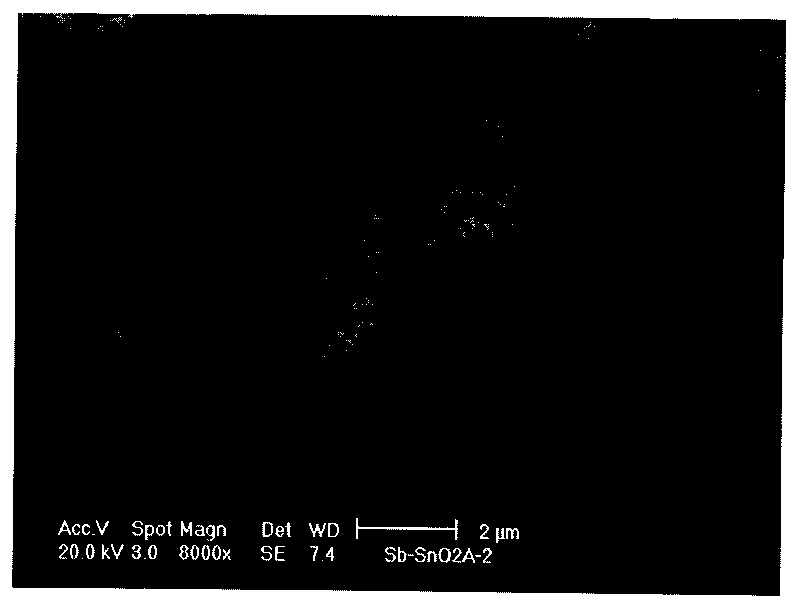Method for manufacturing nano antimony doped tin oxide
A technology of antimony-doped tin oxide and production method, which is applied in tin oxide, nanotechnology, nanotechnology, etc., can solve problems such as unsafe costs, and achieve the effects of low production cost, safe and environmentally friendly production process, simple process and equipment
- Summary
- Abstract
- Description
- Claims
- Application Information
AI Technical Summary
Problems solved by technology
Method used
Image
Examples
example 1
[0019] Mix 100g of stannous oxalate and 8.1g of antimony trioxide, and thermally decompose it at 500°C for 40 minutes. After the thermally decomposed primary product is fully mixed, it is oxidized and roasted at 1100°C for 40 minutes to obtain light blue nano antimony-doped tin oxide powder. . The product is analyzed by electron microscope as a spherical powder with uniform particle size, and its XRD pattern is consistent with the standard pattern of tin dioxide. The primary particle size is 100% less than 100 nanometers according to the particle size analyzer. The nano-antimony-doped tin oxide has different resistivity.
example 2
[0021] 98g of stannous oxalate and 2g of antimony oxalate were mixed uniformly and thermally decomposed at 350°C for 60 minutes. The primary product after thermal decomposition was fully stirred and then oxidized and roasted at 950°C for 80 minutes to obtain light blue nano antimony-doped tin oxide. The product is analyzed by electron microscope as a spherical powder with uniform particle size, and its XRD pattern is consistent with the standard pattern of tin dioxide. The primary particle size is 100% less than 100 nanometers according to the particle size analyzer. The nano-antimony-doped tin oxide has different resistivity.
example 3
[0023] Mix 60g of stannous oxalate and 40g of antimony oxalate, and heat it at 700°C for 30 minutes to decompose it. The primary product after the heat decomposition is fully stirred and then oxidized and roasted at 1300°C for 25 minutes to obtain light blue nano antimony-doped tin oxide. The product is analyzed by electron microscope as a spherical powder with uniform particle size, and its XRD pattern is consistent with the standard pattern of tin dioxide. The primary particle size is 100% less than 100 nanometers according to the particle size analyzer. The nano-antimony-doped tin oxide has different resistivity.
PUM
| Property | Measurement | Unit |
|---|---|---|
| particle size | aaaaa | aaaaa |
| particle size | aaaaa | aaaaa |
Abstract
Description
Claims
Application Information
 Login to View More
Login to View More - R&D
- Intellectual Property
- Life Sciences
- Materials
- Tech Scout
- Unparalleled Data Quality
- Higher Quality Content
- 60% Fewer Hallucinations
Browse by: Latest US Patents, China's latest patents, Technical Efficacy Thesaurus, Application Domain, Technology Topic, Popular Technical Reports.
© 2025 PatSnap. All rights reserved.Legal|Privacy policy|Modern Slavery Act Transparency Statement|Sitemap|About US| Contact US: help@patsnap.com


